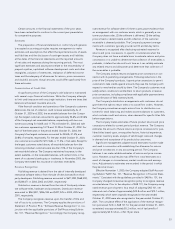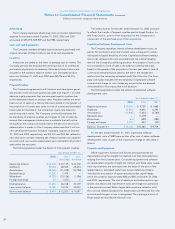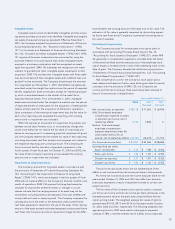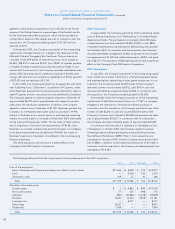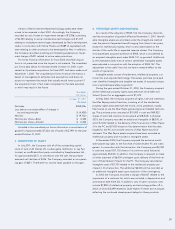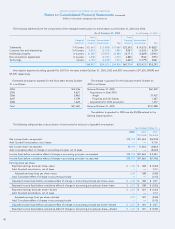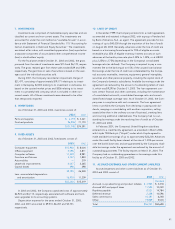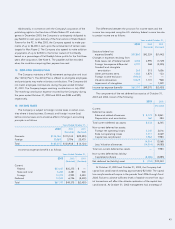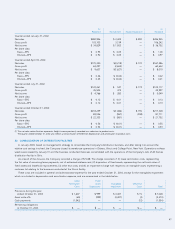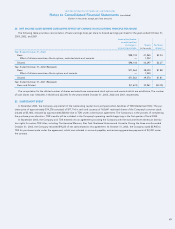2K Sports 2003 Annual Report Download - page 45
Download and view the complete annual report
Please find page 45 of the 2003 2K Sports annual report below. You can navigate through the pages in the report by either clicking on the pages listed below, or by using the keyword search tool below to find specific information within the annual report.
Additionally, in connection with the Company’s acquisition of the
publishing rights to the franchise of Duke Nukem PC and video
games in December 2000, the Company is contingently obligated to
pay $6,000 in cash upon delivery of the final version of Duke Nukem
Forever for the PC. In May 2003, the Company agreed to make pay-
ments of up to $6,000 in cash upon the achievement of certain sales
targets for Max Payne 2. The Company also agreed to make addition-
al payments of up to $2,500 to the former owners of Cat Daddy
based on a percentage of Cat Daddy’s future profits for the first three
years after acquisition. See Note 4. The payables will be recorded
when the conditions requiring their payment are met.
14. EMPLOYEE SAVINGS PLAN
The Company maintains a 401(k) retirement savings plan and trust
(the “401(k) Plan”). The 401(k) Plan is offered to all eligible employees
and participants may make voluntary contributions. The Company did
not match employee contributions during the year ended October
31, 2001. The Company began matching contributions in July 2002.
The matching contribution expense incurred by the Company during
the years ended October 31, 2003 and 2002 was $384 and $95,
respectively.
15. INCOME TAXES
The Company is subject to foreign income taxes in certain coun-
tries where it does business. Domestic and foreign income (loss)
before income taxes and cumulative effect of change in accounting
principle is as follows:
Years Ended October 31,
2003 2002 2001
(Restated) (Restated)
Domestic $134,746 $115,142 $(29,594)
Foreign 30,569 5,796 25,470
Total $165,315 $120,938 $ (4,124)
Income tax expense (benefit) is as follows:
Years Ended October 31,
2003 2002 2001
(Restated) (Restated)
Current:
Federal $33,167 $35,275 $ —
State and local 6,287 4,381 500
Foreign 14,703 2,993 5,450
Deferred 13,040 6,726 (8,400)
Total $67,197 $49,375 $(2,450)
The differences between the provision for income taxes and the
income tax computed using the U.S. statutory federal income tax rate
to pretax income are as follows:
Years ended October 31,
2003 2002 2001
(Restated) (Restated)
Statutory federal tax
expense (benefit) $57,860 $42,324 $(1,442)
Changes in expenses resulting from:
State taxes, net of federal benefit 4,035 2,995 (1,729)
Foreign tax expense differential 2,191 568 (3,355)
Goodwill and intangible
amortization 363 513 1,656
Other permanent items 1,482 1,874 123
Foreign income exclusion (9,163) ——
Valuation allowances 10,429 1,101 968
Impairment of intangibles —— 1,329
Income tax expense (benefit) $67,197 $49,375 $(2,450)
The components of the net deferred tax asset as of October 31,
2003 and 2002 consist of the following:
2003 2002
(Restated)
Current:
Deferred tax assets:
Sales and related allowances $ 8,173 $ 5,861
Depreciation and amortization 160 384
Total current deferred tax assets 8,333 6,245
Non-current deferred tax assets:
Foreign net operating losses 3,240 2,016
State net operating losses 3,311 2,069
Capital loss carryforward 7,963 7,983
14,514 12,068
Less: Valuation allowances (14,514) (4,085)
Total non-current deferred tax assets —7,983
Non-current deferred tax liability:
Capitalized software (8,486) (3,885)
Net deferred tax (liability) asset $ (153) $10,343
At October 31, 2003 and October 31, 2002, the Company had
capital loss carryforwards totaling approximately $21,000. The capital
loss carryforwards will expire in the periods fiscal 2006 through fiscal
2008. Failure to achieve sufficient levels of taxable income from capi-
tal transactions will affect the ultimate realization of the capital loss
carryforwards. At October 31, 2002 management had a strategy of
43


